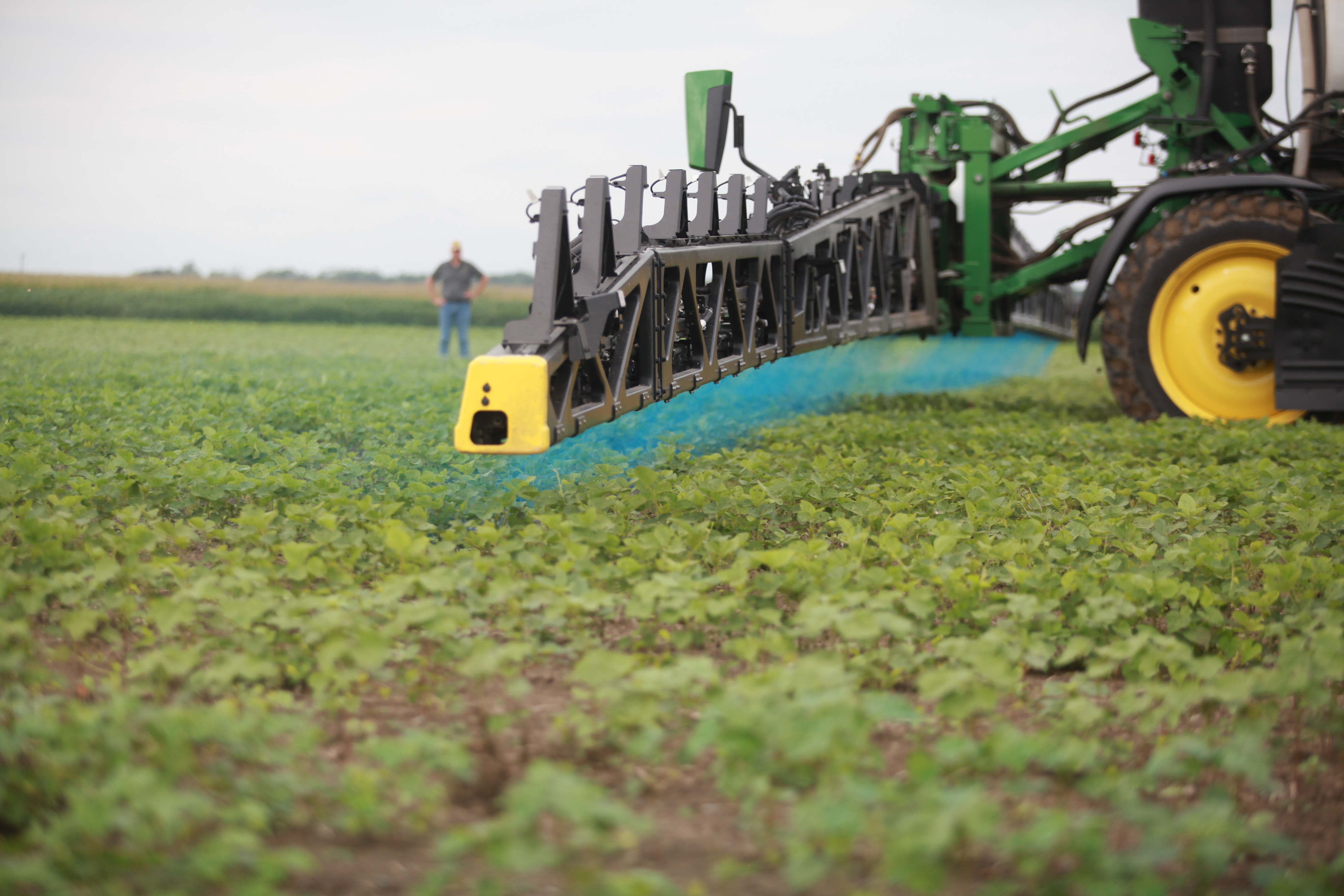Division of Agriculture demonstrates one possible ‘future of weed control’
Aug. 26, 2022
By Ryan McGeeney
U of A System Division of Agriculture
Fast Facts:
- Aug. 23 demonstration at Keiser facility shows ‘See & Spray’ system in action
- System developed with assessments and feedback from four land grant universities
- System available in limited release in 2023
(675 words)
(Newsrooms: With additional art at https://flic.kr/s/aHBqjA4ipa)
KEISER, Ark. — The future of weed control may come down to selectivity.
Using visual recognition and machine learning to selectively spray pesticides in crop fields, versus simply broadcasting chemicals over an entire area, is the core concept behind a technology that researchers with the University of Arkansas System Division of Agriculture have been evaluating for several years.
On Aug. 23, growers, consultants and other agriculture industry professionals had the opportunity to see an iteration of that technological concept in action at the Division of Agriculture’s Northeast Research and Extension Center at Keiser in northeast Arkansas.
The system, known as See & Spray Ultimate, uses a series of digital cameras mounted on 120-foot booms affixed to a tractor to identify and spot-spray weeds in post-emergent applications. The original concept was developed by Blue River Technology in California to thin lettuce patches. When John Deere acquired Blue River about five years ago, the concept was expanded to identify and eradicate weeds in row crop agriculture.
Jason Norsworthy, distinguished professor of weed science for the Division of Agriculture, has been evaluating the system in test plots at the Keiser Research Station since 2017. Norsworthy, whose work is part of the Arkansas Agricultural Experiment Station, the Division of Agriculture’s research arm, said that between growing resistance to existing chemistries and increasing environmental concern, technologies like the See & Spray are likely to become increasingly necessary in row crop agriculture.
“Each year, we’re losing herbicides because of environmental contamination,” he said. “Being able to place the herbicide where the weed actually is will make those herbicides more efficient.”
During Tuesday’s demonstration, a John Deere employee drove a tractor over a cotton test plot, spraying water with blue dye over the rows using nozzles on a 120-foot tractor boom. The purpose was to demonstrate the system’s coverage at both relatively low and high weed detection settings and tractor speeds.
Norsworthy discussed typical reductions in herbicide consumption using both broadcast and selective “spot” spraying, as well as additional ramifications of each approach.
“I don’t think that this technology is going to be one to allow us to take the residual herbicides out of the post-emergence applications, but it is going to put more emphasis on trying to keep those fields clean, and in doing so, I think there’s considerable cost savings that can result when we have strong residuals,” he said. “I think what we’ve seen today is the first of many more iterations to come. It’s really the platform — as the software and computer speed evolves, I think we’re going to see further advancements in terms of being able to locate and identify weeds and properly target that spray application.”
After the tractor demonstration, Tom Barber, extension weed scientist for the Division of Agriculture, moderated a panel discussion that addressed questions about the See & Spray Ultimate technology. The panel included Norsworthy, Tom several John Deere and Blue River Technology representatives and several Arkansas farmers.
Travis Senter, a Mississippi County farmer who had participated in evaluating the technology, said it took some getting used to.
“We used the sprayer on several crops,” Senter said. “We used it on rice … we used it on some beans, but mostly we used it on cotton. It’s got its place.
“It took us a while for my driver to kind of get acclimated to it,” he said. “We were actually a little scared of it. And once we got in it and got going, it works good.”
Chad Yagow, John Deere business agronomy lead for the See & Spray Ultimate system, said the company has been working with four land grant universities, including the University of Arkansas, to develop and improve the technology, as well as running mirror trials with a contract research firm in Mississippi.
Yagow said 50 units will be available for purchase in 2023. In 2024, John Deere plans to release more units to the open market, based on consumer demand. Pricing details for the system will be released to the public through John Deere dealers on Sept. 15, he said.
To learn about extension programs in Arkansas, contact your local Cooperative Extension Service agent or visit www.uaex.uada.edu. Follow us on Twitter and Instagram at @AR_Extension. To learn more about Division of Agriculture research, visit the Arkansas Agricultural Experiment Station website: https://aaes.uada.edu/. Follow on Twitter at @ArkAgResearch. To learn more about the Division of Agriculture, visit https://uada.edu/. Follow us on Twitter at @AgInArk.
About the Division of Agriculture
The University of Arkansas System Division of Agriculture’s mission is to strengthen agriculture, communities, and families by connecting trusted research to the adoption of best practices. Through the Agricultural Experiment Station and the Cooperative Extension Service, the Division of Agriculture conducts research and extension work within the nation’s historic land grant education system.
The Division of Agriculture is one of 20 entities within the University of Arkansas System. It has offices in all 75 counties in Arkansas and faculty on five system campuses.
Pursuant to 7 CFR § 15.3, the University of Arkansas System Division of Agriculture offers all its Extension and Research programs and services (including employment) without regard to race, color, sex, national origin, religion, age, disability, marital or veteran status, genetic information, sexual preference, pregnancy or any other legally protected status, and is an equal opportunity institution.
# # #
Media Contact:
Ryan McGeeney
rmcgeeney@uada.edu
@Ryan_McG44
501-671-2120
